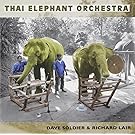Dec. 31st, 2019
Thai Elephant Orchestra
Dec. 31st, 2019 01:22 pmThai Elephant Orchestra (with Dave Soldier & Richard Lair)
2002 (Mulatta)
00:00 Thung Kwian Sunrise
06:07 Temple Music
09:07 Rainforest
10:56 Jojo
14:41 Duo For Renats
16:23 Big Band
19:15 Swing swing swing
22:59 Percussion Trio
25:32 Luuk Kob's Diddley Bow Feature
30:00 Harmonica Music
34:55 Heavy Logs
39:41 Noe We're off to Paint
𝘕𝘢𝘵𝘶𝘳𝘢𝘭 𝘌𝘭𝘦𝘱𝘩𝘢𝘯𝘵 𝘚𝘰𝘶𝘯𝘥𝘴
44:14 Elephant Field Recording
𝘌𝘭𝘦𝘱𝘩𝘢𝘯𝘵𝘴 𝘞𝘪𝘵𝘩 𝘏𝘶𝘮𝘢𝘯𝘴
47:53 Somneuk & Flour Elephants
51:13 Trio For Theremin & Electric Keyboard
53:16 Ken's Wind Instrument
THAI ELEPHANT ORCHESTRA In 1999, composer Dave Soldier and ‘elephantologist’ Richard Lair met at the Thai Elephant Conservation Centre, where some of the 2500 survivors of Thailand’s 100,000 logging elephants still have to work for a living. As a career option for the rescued pachyderms, Lair and Soldier proposed that they play music for tourists. Elephants are highly intelligent social animals and rapidly took to many of the instruments Soldier designed for them to play with their trunks – giant slit drums, large marimba-like renats, the single string bass diddly-bow, a gong, mouth organ and reed instruments. “The notes and rhythms of the pieces were chosen completely by the elephants,” Soldier commented. He didn’t teach elephants to play prewritten human melodies but wanted to hear how they chose to play: “They play variously in duple meter... triple meter... and a dotted rhythm... Sometimes they found motifs for a particular piece and repeated them.” The harmonica became a fad for the animals – one morning Soldier arrived to hear it echoing all round the hills. One female elephant, at first frightened by the gong, learned to strike it on command; by the third day she refused to stop hitting it. The effect, to Western ears, is like children trying to play a gamelan orchestra – the sense of time unsteady, note choice a bit random, but the results, as heard on Thai Elephant Orchestra (Mulatta CD), are very enjoyable. The elephant diddly-bowing on “Rainforest” lays down a thunderous if uncertain groove, while the wheezy reed sounds on “JoJo” are hilarious. (AH)
Anthony Peteras
Dec. 31st, 2019 02:25 pmThe title track of Anthony Pateras’s Mutant Theatre (Tzadik CD) is a percussion piece for solo dominoes, balloon-prepared mousetraps, percussion, toys and cheap electronics. As the composer explains, “It begins with this 600-domino tree going off into mousetraps prepared with inflated water balloons, going instantly into the contact-miked cymbal producing a wall of noise à la Merzbow.” It never recovers its sanity – and you can see why its cartoonish quality appealed to Tzadik host John Zorn. Even more cut ’n’ paste is “Twitch” for a quintet of viola/decrepit violin, contrabass recorder, trombone/conch, laptop/live processing and percussion. Just your standard lineup, then. It offers a Klangfarbenmelodie of sound effects, with everything in flux and nothing sustained – the decrepit violin seems to be taken apart at the end. But there’s a serious purpose behind all this craziness. Pateras’s description is “anti-classical music utilising notational conventions from the avant-garde tradition, combined with electronic noise and spasmodic pianistics primarily influenced by Conlon Nancarrow”. Born 1979 in Melbourne, his work bridges two divides between composition and improvisation, and between electronic and traditional acoustic instrumental resources. Improv and composition interpenetrate seamlessly, and his notated pieces have the energy of improvisations. The manic, punkish quality of the music is reflected in the man – who could easily double as a stand-up comic, even if his routines might strike audiences as a little strange.
(Wire mag)

